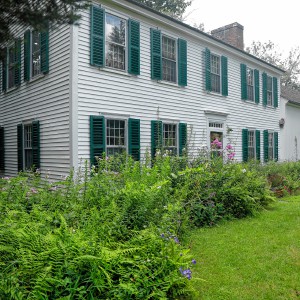
Enslaved from 1770 to 1776 at the Forty Acres homestead in Hadley, now known as The Porter-Phelps-Huntington House Museum, Caesar Phelps wrote a letter from Fort Ticonderoga, where he was serving in the Continental Army, to his owner, Charles Phelps, asking that he not be sold again.
After sending that letter, Caesar disappears from recorded history, the remainder of his life unknown today.
Margaret “Peg” Bowen was enslaved when she was 12 and gave birth to two children at Forty Acres, but then negotiated with Charles Phelps to be sold to a man in Bennington, Vermont, so she could be with her husband. Peg was later sold back to Charles Phelps and returned to Hadley in 1778, earning her freedom four years later.
Ceasar and Peg are among several enslaved individuals and indentured servants, including two British soldiers, who lived and worked at the Forty Acres farmstead, and whose underdocumented lives should become better known through additional research that will be completed using a $40,000 grant from the National Endowment for the Humanities.
The money is coming to the museum in advance of the 250th birthday of the United States in 2026 and will mostly go toward undergraduate research. It is one of three local projects sharing portions of $37.5 million being provided for 240 projects across the country.
“When the museum was first founded, it was to tell the stories of Revolutionary heroes,” says Karen Sanchez-Eppler, who is leading the project titled “Forty Acres and the American Revolution: Stories of Independence and Servitude.” “We’ve been working for the last bunch of years to expand the narrative that tries to honor all lives lived in connection to the place.”
The farmstead, built in 1752 by Moses Porter, is full of Revolutionary War era materials and stories from Elizabeth Porter Phelps, the second-generation owner whose diary, beginning in the 1760s until her death in 1817, is a primary source for much of the knowledge about those who lived and worked there.
“In an ideal world, this will allow us to know more about their lives,” said Sanchez-Eppler, also the L. Stanton Williams 1941 Professor of American Studies and English at Amherst College.
Article continues after…
The other two local projects will support institutes for K-12 educators.
At UMass, $171,962 is going toward “The Souls of Black Folk,” a two-week residential institute for 25 high school teachers to learn the fundamentals of African American studies.
During the program next year, instructors will work with teachers who have expressed interest in preparing to offer the new Advanced Placement African American Studies course or expanding their content knowledge and pedagogy in African American studies.
The institute is being led by Toussaint Losier, associate professor in the Department of Afro-American Studies; Yolanda Covington-Ward, who chairs the Department of Afro-American Studies; A Yemisi Jimoh, a professor in the Department of Afro-American Studies; and Keisha Green, associate professor of teacher education and curriculum studies at the College of Education and co-founder and co-director of the Center of Racial Justice and Youth Engaged Research.
Losier said the team that put this grant together carried out a series of teacher enrichment workshops with Massachusetts educators focusing on the fundamentals of African American studies.
At Amherst College, $200,000 will support “Punishment: The American Story,” a three-week residential institute for 25 middle and high school teachers on the meanings, purposes and history of punishment in the United States. This is being led by Austin Sarat, the college’s William Nelson Cromwell Professor of Jurisprudence and Political Science, and will be held on the Amherst campus next July.
Back at Porter-Phelps Huntington, Sanchez-Eppler said an exhibit will be ready for next summer in the Corn Barn that will tell the stories of Caesar and Peg, along with indentured servants John Morrison and George and Mary Andries.
Morrison, a British soldier from Scotland, was captured from a ship in Boston Harbor and sent to work at Forty Acres. An ornamental gardener, he brought his expertise to Hadley, and remnants of the garden are still visible.
George Andries is presumed to be among the Hessian soldiers defeated at Saratoga and then marched eastward to become an indentured farmer. Both Andries are referenced in Phelps’ diary.
“These stories about those who came and decided to stay in the New World, to become American farm laborers, is another part we don’t tell much,” Sanchez-Eppler said.
The hope is to have Morrison’s garden completed by the summer of 2026.
Sanchez-Eppler said that the research can yield interesting stories, like that of Capt. Stephen Fay, who bought Peg Bowen and then, even as his son Jonas was instrumental in writing the Vermont state Constitution adopted in 1777 prohibiting adult slavery, agreed to sell Peg back to Charles Phelps, with the bill of sale witnessed by his son.
“That stands stark as an example of the contradictions between independence and servitude during the American Revolution,” Sanchez-Eppler said.




